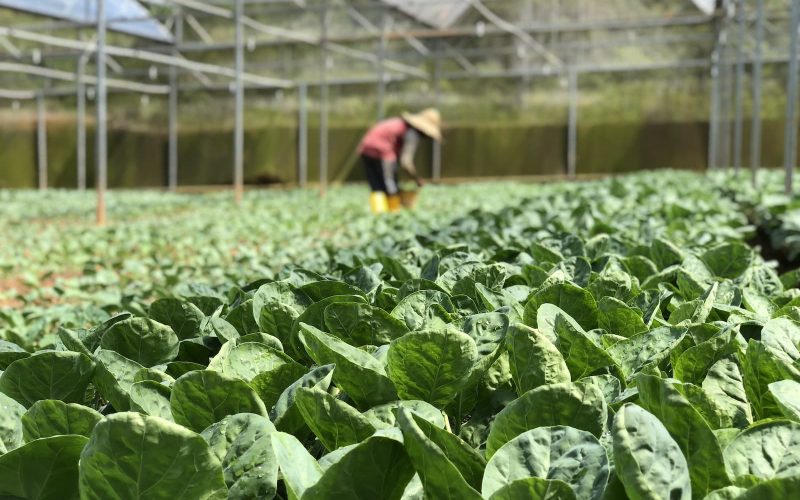When it comes to constructing a greenhouse, the choice of materials is of utmost importance.
The materials used for the frame and glazing play a crucial role in the overall performance and durability of the structure.
Let’s explore the basics of greenhouse materials and understand why choosing the right ones is essential.
Introduction to Greenhouse Construction
A greenhouse is a structure designed to create an ideal environment for plants by harnessing sunlight and providing protection from the elements.
It allows you to extend the growing season and cultivate plants that may not thrive in your region’s natural climate.
Greenhouse construction typically involves two main components: the frame and the glazing.
The frame serves as the structure’s skeleton, providing stability and support, while the glazing materials form the walls and roof, allowing sunlight to enter and trapping heat inside.
Importance of Choosing the Right Materials
Choosing the right materials for your greenhouse is crucial for several reasons.
Firstly, the materials will determine the durability and longevity of your structure.
A well-constructed greenhouse made with quality materials can withstand the test of time and provide you with many years of successful gardening.
Secondly, the materials used in your greenhouse will impact its insulation and energy efficiency.
Proper insulation is essential to maintain a stable and favorable climate for your plants, regardless of the external weather conditions.
The right materials will help retain heat during colder months and prevent excessive heat buildup during warmer periods.
Lastly, the choice of materials will affect the greenhouse’s light transmission and UV protection.
Different glazing materials have varying degrees of light transmission, which directly impacts plant growth and productivity.
UV protection is crucial to shield your plants from harmful UV rays that can cause damage.
To make an informed decision about the materials for your greenhouse, it’s important to consider factors such as cost, availability, and maintenance requirements.
Assessing your specific needs and the environmental conditions in your area will help you determine the most suitable materials for your greenhouse project.
In the following sections, we will delve deeper into the different types of materials commonly used for greenhouse frames and glazing.
Understanding these options will provide you with the knowledge needed to make an informed decision based on your specific requirements.
As you continue your journey through the world of greenhouse materials, remember to prioritize the durability, insulation, and light transmission aspects to create an optimal growing environment for your cherished plants.
Frame Materials
When it comes to constructing a greenhouse, the frame material plays a crucial role in providing structural support and durability.
There are several options to consider, including wood frames, aluminum frames, and steel frames.
Wood Frames
Wood frames have long been a popular choice for greenhouse construction.
They offer a timeless and natural aesthetic, blending seamlessly with garden surroundings.
Wood frames provide excellent insulation properties, helping to maintain a stable internal temperature and reduce energy costs.
However, it’s important to note that wood frames require regular maintenance to ensure their longevity.
They may need to be treated with wood preservatives or sealants to protect against moisture, rot, and pests.
Consider using pressure-treated or rot-resistant wood for increased durability.
Check out our article on how to clean greenhouse plastic for maintenance tips that can also be applied to wood frames.
Aluminum Frames
Aluminum frames are popular for modern greenhouses due to their durability, lightweight nature, and low maintenance requirements.
They provide excellent strength and resistance to corrosion, making them ideal for outdoor installations.
Aluminum frames are also highly customizable, allowing for various design options and configurations.
Another advantage of aluminum frames is their ability to withstand extreme weather conditions, including high winds and heavy snow loads.
They require minimal maintenance, typically only needing occasional cleaning to remove dirt and debris.
For more information on how to properly care for your greenhouse, refer to our article on how to use a portable greenhouse.
Steel Frames
Steel frames offer exceptional strength and durability, making them suitable for larger-scale or commercial greenhouse projects.
They provide excellent structural support and can withstand heavy loads and extreme weather conditions.
Steel frames are resistant to warping, bending, and shrinking, ensuring a long-lasting greenhouse structure.
While steel frames are incredibly sturdy, they may require additional insulation to prevent excessive heat loss during colder months.
Consider using insulation materials like bubble wrap or double-glazed panels to enhance the energy efficiency of your steel-framed greenhouse.
For more information on greenhouse insulation, refer to our article on how to heat a greenhouse.
By carefully considering the pros and cons of each frame material, you can select the option that best suits your needs and preferences.
Whether you choose wood, aluminum, or steel, ensure that the frame material aligns with your climate, budget, and greenhouse design.
Remember to maintain your greenhouse regularly to maximize its lifespan and enjoy the benefits of a thriving plant-filled oasis.
Glazing Materials
When it comes to choosing the materials for the glazing of your greenhouse, there are several options available.
The glazing material you select will impact factors such as insulation, light transmission, durability, and cost.
Let’s explore three common glazing materials: glass, polycarbonate, and polyethylene film.
Glass
Glass has been a popular choice for greenhouse glazing for many years.
It provides excellent clarity and allows for maximum light transmission, which is essential for the growth of plants.
Glass is also highly durable, resistant to scratches, and can withstand extreme weather conditions.
One of the key advantages of glass is its ability to retain heat, providing good insulation during cooler periods.
However, glass can be heavier and more expensive than other glazing materials. Additionally, it may require additional structural support due to its weight.
Polycarbonate
Polycarbonate is a lightweight and durable alternative to glass. It is known for its impact resistance and ability to diffuse light, reducing the risk of hot spots in the greenhouse.
Polycarbonate panels are available in various thicknesses, providing different levels of insulation.
Polycarbonate is also more flexible than glass, allowing for easy installation and customization.
It is less likely to break or shatter, making it a safer option, especially in areas prone to high winds or hail.
However, polycarbonate may experience some yellowing or loss of transparency over time.
Polyethylene Film
Polyethylene film is the most cost-effective option for greenhouse glazing.
It is lightweight, easy to install, and provides good light transmission.
Polyethylene film is available in different thicknesses, with thicker films offering better insulation properties.
While polyethylene film is economical, it has a shorter lifespan than glass or polycarbonate.
It may need to be replaced every few years due to UV exposure and wear and tear degradation.
However, with proper care and maintenance, polyethylene film can be a practical solution for temporary or seasonal greenhouses.
| Glazing Material | Durability | Insulation | Light Transmission |
|---|---|---|---|
| Glass | High | Good | Excellent |
| Polycarbonate | High | Varies (depending on thickness) | Good |
| Polyethylene Film | Low to Medium | Varies (depending on thickness) | Good |
Choosing the right glazing material for your greenhouse depends on factors such as budget, climate, and personal preference.
Consider the specific needs of your plants and your local weather conditions when making your decision.
For more information on greenhouse construction and maintenance, check out our article on how to use a portable greenhouse.
Considerations for Greenhouse Materials
When selecting materials for your greenhouse, there are several important considerations to keep in mind.
The materials you choose will have a significant impact on the performance and longevity of your greenhouse.
Pay attention to factors such as durability and longevity, insulation and energy efficiency, and light transmission and UV protection.
Durability and Longevity
One of the key considerations when choosing greenhouse materials is their durability and longevity.
Greenhouses are exposed to various environmental factors such as wind, rain, snow, and intense sunlight.
Therefore, it’s essential to select materials that can withstand these conditions.
For frame materials, options such as wood, aluminum, and steel each have their own durability characteristics.
Wood frames can provide a natural and aesthetically pleasing look but may require more maintenance over time.
Aluminum frames are lightweight, corrosion-resistant, and generally long-lasting.
Steel frames are known for their strength and durability, making them suitable for larger or commercial greenhouses.
Consider factors such as the climate in your area and the expected lifespan of the materials when making your decision.
Glazing materials also play a vital role in the durability and longevity of your greenhouse.
Glass is a traditional choice that offers excellent durability. Still, it can be more prone to breakage.
Polycarbonate is a lightweight and impact-resistant option, making it a popular choice for its durability.
Polyethylene film is a cost-effective option but may need replacement more frequently.
Evaluate the pros and cons of each material to find the best fit for your needs.
Insulation and Energy Efficiency
Insulation and energy efficiency are crucial factors to consider when selecting greenhouse materials.
Proper insulation helps regulate temperature and reduce heat loss, allowing for more consistent growing conditions and energy savings.
The choice of frame materials can impact the insulation properties of your greenhouse.
Wood frames, for example, provide natural insulation, helping to retain heat.
Aluminum and steel frames, on the other hand, may require additional insulation measures to improve energy efficiency.
Glazing materials also contribute to the insulation and energy efficiency of your greenhouse.
Despite its durability, glass has lower insulation properties than other options.
Polycarbonate and polyethylene film offer better insulation, reducing heat loss and potentially lowering heating costs.
Consider the climate in your region and the desired temperature control within your greenhouse when selecting materials.
Maximizing insulation is crucial for maintaining a suitable growing environment year-round if you live in a colder climate.
For more information on heating your greenhouse, check out our article on how to heat a greenhouse.
Light Transmission and UV Protection
Light transmission and UV protection are essential considerations for greenhouse materials, as they directly impact plant growth and health.
Greenhouse materials should allow sufficient sunlight to reach the plants while minimizing harmful UV radiation.
Glass provides excellent light transmission, allowing a high percentage of sunlight to enter the greenhouse.
However, it may not offer sufficient UV protection, requiring additional measures such as shading or coatings.
Polycarbonate and polyethylene film are available in various grades, some specifically designed for greenhouse applications.
These materials can provide good light transmission while offering UV protection.
Some polycarbonate options even have built-in UV filters to safeguard your plants.
When selecting glazing materials, consider the specific light requirements of your plants and balance that with the need for UV protection.
Providing the right amount of light and protecting your plants from excessive UV exposure is crucial for their growth and overall well-being.
By considering factors such as durability and longevity, insulation and energy efficiency, and light transmission and UV protection, you can make informed decisions when choosing materials for your greenhouse.
Remember to assess your specific needs and the conditions in your area to determine the most suitable materials for your greenhouse project.
Additional Components and Materials
There are several additional components and materials to consider to create a functional and efficient greenhouse.
These include flooring options, ventilation systems, and shelving and benches.
Flooring Options
Choosing the right flooring for your greenhouse is important for maintaining a clean and productive environment.
Some common flooring options for greenhouses include:
| Flooring Material | Description |
|---|---|
| Concrete | Provides a durable and easy-to-clean surface. Suitable for heavy-duty use and high traffic areas. |
| Gravel | Allows for good drainage and helps to control weeds. Offers a more natural look and feel. |
| Paving Stones | Offers a solid surface while providing a decorative element to the greenhouse. Allows for easy movement of equipment and plants. |
| Rubber Mats | Provides cushioning and reduces fatigue when standing for long periods. Offers good traction and can be easily cleaned. |
Consider your specific needs and preferences when choosing the flooring material for your greenhouse.
It should be able to withstand moisture, provide good drainage, and be easy to clean.
Ventilation Systems
Proper ventilation is essential for maintaining a healthy and productive greenhouse environment.
Ventilation systems help to regulate temperature, control humidity, and prevent the buildup of stale air.
Here are some common types of ventilation systems used in greenhouses:
- Roof Vents: Mounted on the greenhouse roof, these vents allow hot air to escape and fresh air to enter, promoting air circulation.
- Side Vents: Positioned along the sides of the greenhouse, these vents help to create cross ventilation, allowing for efficient air exchange.
- Exhaust Fans: Installed in the walls or roof, exhaust fans help to expel hot air and draw in cool air from outside.
- Shade Cloth: By reducing the amount of sunlight entering the greenhouse, shade cloths help to regulate temperature and prevent overheating.
Consider the size of your greenhouse, climate conditions, and the specific needs of your plants when choosing a ventilation system.
Proper airflow is crucial for maintaining optimal growing conditions.
Shelving and Benches
Shelving and benches provide valuable space for organizing and displaying your plants in the greenhouse.
They help to maximize available space and make it easier to tend to your plants.
Some common options for shelving and benches include:
- Wire Shelving: Lightweight and versatile, wire shelving allows for good airflow and drainage. Ideal for displaying smaller potted plants.
- Wooden Benches: Sturdy and aesthetically pleasing, wooden benches provide a solid surface for larger plants and can be customized to fit your greenhouse layout.
- Metal Benches: Durable and easy to clean, metal benches are resistant to moisture and can withstand heavy pots and trays.
When choosing shelving and benches, consider the weight capacity, durability, and the specific needs of your plants.
Ensure that they are appropriately sized and positioned to allow for easy access and efficient use of space within the greenhouse.
By carefully selecting the additional components and materials for your greenhouse, you can create a functional and productive space for your plants to thrive.
Whether it’s choosing the right flooring, implementing an effective ventilation system, or organizing your plants with shelving and benches, each element plays a vital role in the overall success of your greenhouse.
Maintaining and Upgrading Greenhouse Materials
Regular cleaning and maintenance are essential to ensure your greenhouse’s longevity and optimal performance.
Additionally, there may come a time when you want to upgrade your greenhouse materials to enhance their functionality and efficiency.
This section will discuss some key tips for cleaning and maintaining your greenhouse materials and considerations for upgrading them.
Cleaning and Maintenance Tips
Proper cleaning and maintenance of your greenhouse materials are crucial for maintaining a healthy growing environment.
Here are some tips to keep in mind:
- Regularly clean the glazing materials: Whether you have glass, polycarbonate, or polyethylene film, it’s important to clean the glazing materials to maximize light transmission. Use a mild detergent and warm water to remove dirt, dust, and algae. Avoid using abrasive cleaners or tools that can scratch the surface.
- Inspect and repair any damages: Regularly inspect your greenhouse frame and glazing materials for any signs of damage, such as cracks, leaks, or loose components. Repair or replace any damaged parts promptly to prevent further deterioration.
- Clear debris and maintain proper drainage: Remove any fallen leaves, plant debris, or other obstructions from the gutters, downspouts, and drainage systems. This will help prevent clogs and ensure proper water drainage.
- Check and maintain the ventilation system: Clean and lubricate your greenhouse ventilation system’s hinges, motors, and other components. This will ensure smooth operation and prevent malfunctions that can impact temperature and humidity control.
For more detailed information on cleaning and maintaining your greenhouse, refer to our article on how to clean greenhouse plastic.
Upgrading Materials for Better Performance
Over time, you may find it beneficial to upgrade certain greenhouse materials to improve their overall performance.
Here are some considerations for potential upgrades:
- Glazing materials: Upgrading from polyethylene film to polycarbonate or glass can provide better insulation, durability, and UV protection. Consider the specific requirements of your plants and climate when selecting the appropriate glazing material.
- Frame materials: If your greenhouse frame is showing signs of wear or lacks stability, upgrading from wood to aluminum or steel can provide better structural integrity and longevity. Aluminum frames are lightweight and resistant to corrosion, while steel frames offer exceptional strength.
- Insulation: Adding additional insulation, such as double-layered glazing or insulated panels, can help improve greenhouse energy efficiency and temperature control. This is particularly important in colder climates.
- Ventilation: Upgrading your ventilation system to include automated controls, such as temperature and humidity sensors, can enhance air circulation efficiency and temperature management. This ensures a healthier growing environment for your plants.
Before making any upgrades, carefully assess your greenhouse’s specific needs and consult with professionals if necessary.
Upgrading materials can improve energy efficiency, plant growth, and overall greenhouse performance.
By following proper cleaning and maintenance practices and considering potential upgrades, you can extend the lifespan of your greenhouse materials and create an optimal environment for your plants to thrive.








